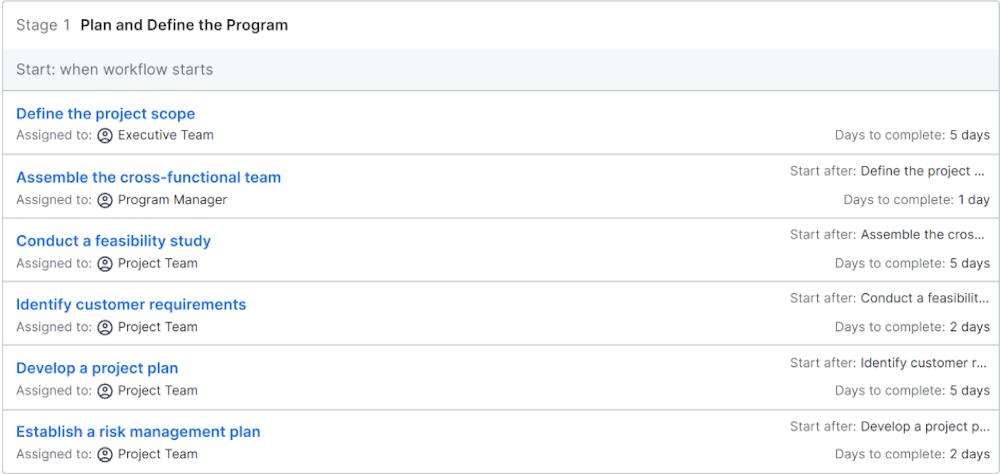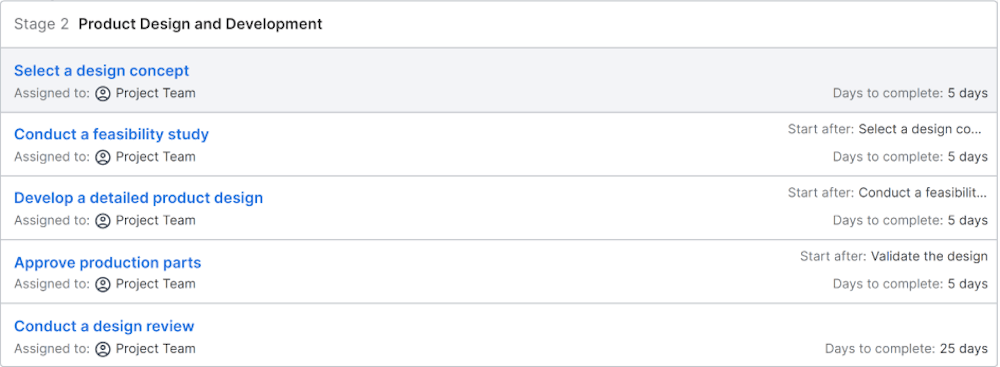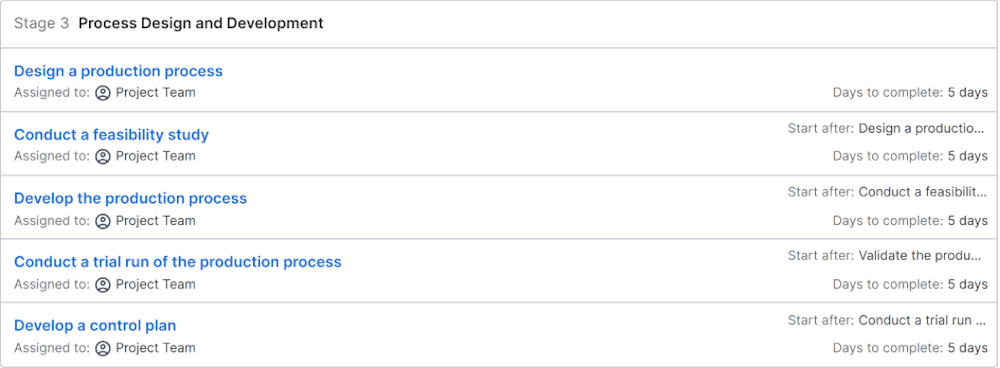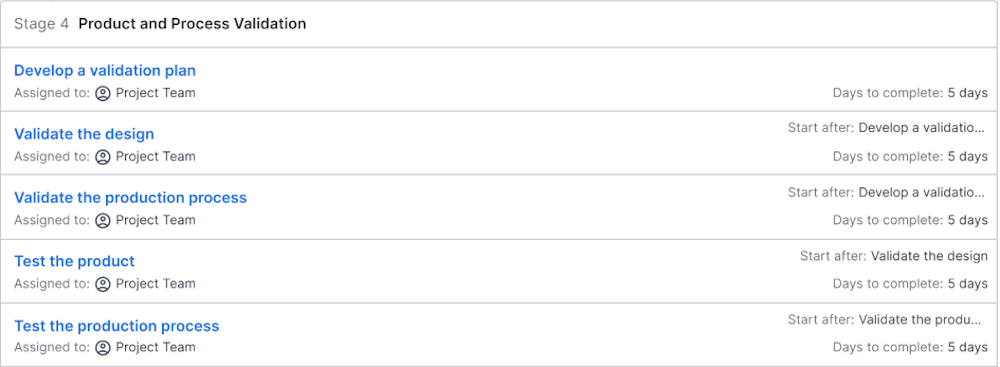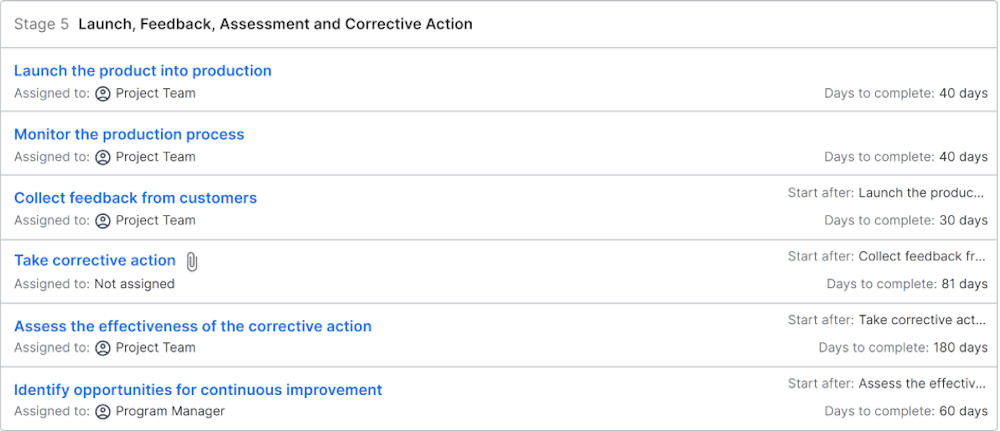Advanced Product Quality Planning (APQP)
Advanced Product Quality Planning (APQP) is a structured and systematic approach to designing and developing new products or processes while considering potential quality issues that may arise during the development process. APQP facilitates communication between the supply chain, the organization, and its customers. While APQP has its roots in the automotive industry, it can also be applied to other industries as well. It’s a proactive approach that involves cross-functional teams working together to identify potential risks and issues before they occur. The goal is to ensure that a product or process meets or exceeds customer expectations, is reliable, and is delivered on time and within budget.
APQP has five phases: planning and defining the program, product design and development, process design and development, product and process validation, and product launch, feedback, assessment and corrective action. By following the APQP process, organizations can ensure that their products or processes are designed and developed with quality in mind, leading to better customer satisfaction and greater operational and financial success.
STAGES

The following stages are identified in the blueprint:
Planning and Defining the Program
The planning and defining the program phase of APQP sets the foundation for the rest of the process. It involves establishing the project goals, defining the scope of the project, identifying the customer's requirements, and assembling the cross-functional team that will be responsible for the project. Tools in this area include Quality Function Deployment (QFD), aka Voice of the Customer.
Product Design and Development
The product design and development phase of APQP focuses on designing and developing a product that meets the customer's requirements and is manufacturable. This phase involves the cross-functional team working together to develop a product that is reliable, meets customer needs, and can be produced at a reasonable cost. Important tools in this stage include Design for Manufacturing / Assembly (DFM/A), Design Failure Mode and Effects Analysis (DFMEA), and Design Verification Plan and Report (DVP&R).
Process Design and Development
The process design and development phase of APQP focuses on designing and developing a production process that can produce the product consistently, efficiently, and within specifications. This phase involves the cross-functional team working together to develop a production process that meets customer requirements, is reliable, and can be implemented with the available resources. Important tools in this stage include process flow charts, Process Failure Mode and Effects Analysis (PFMEA), and Control Plan Methodology.
Product and Process Validation
The product and process validation phase of APQP focuses on validating the product and production process to ensure that they meet customer requirements and are capable of producing the product consistently and efficiently. This phase involves the cross-functional team working together to test and verify the product and production process through a series of tests and analysis.
Launch, Feedback, Assessment and Corrective Action
The product launch, feedback, assessment, and corrective action phase of APQP focuses on launching the product into production, monitoring the production process, collecting feedback from customers, and taking corrective action as needed to maintain product quality and customer satisfaction. This phase involves the cross-functional team working together to ensure that the product meets customer requirements and is produced consistently and efficiently.
WHO SHOULD USE THIS PROCESS
APQP is a structured approach to product and process development that can be applied to any industry that involves the design and manufacture of products. It can be used in any industry that requires the development of products and processes and can be tailored to meet the specific needs and requirements of each industry.
APQP was originally developed for the automotive industry but has since been adopted by many other industries, including aerospace, defense, medical devices, electronics, and consumer products. The focus on early identification and prevention of quality issues, cross-functional team collaboration, supplier collaboration, and continuous improvement and can help to ensure that products and processes are developed to meet customer requirements and industry standards.
APQP can be particularly beneficial for industries that are subject to stringent regulatory requirements, such as medical devices and aerospace, where product safety and reliability are critical. By applying the APQP framework, organizations can ensure that they meet these requirements while also improving efficiency, reducing costs, and enhancing customer satisfaction.
WHY USE THIS PROCESS
Companies use the structured framework of APQP to improve product quality, reduce costs, optimize the supply chain, improve efficiency, enhance customer satisfaction, comply with industry standards and regulations, promote collaboration and teamwork and improve their overall competitiveness in the marketplace.
A company would use Advanced Product Quality Planning (APQP) for a number of reasons.
Improve product quality: APQP helps to identify potential quality issues early in the development process, allowing the team to take corrective action and prevent quality problems from occurring.
Reduce costs: By identifying and addressing quality issues early in the development process, APQP can help to avoid costly rework, scrap, and other quality-related costs.
Improve efficiency: APQP can help to streamline the development process and ensure that the production process is as efficient as possible, reducing lead times and improving overall productivity.
Enhance customer satisfaction: By focusing on meeting customer requirements and expectations, APQP can help to ensure that the final product meets or exceeds customer expectations, leading to higher customer satisfaction.
Strengthen supplier relationships: APQP can help to enhance supplier relationships and promote collaboration between the cross-functional team and suppliers. By working together to develop and implement quality plans and improvement initiatives, the team and suppliers can establish a strong partnership that promotes continuous improvement, cost management, and innovation.
Comply with industry standards and regulations: APQP helps companies to ensure their products and processes meet the requirements of industry standards and regulations, such as those related to safety, quality, and environmental sustainability.
Promote collaboration and teamwork: APQP encourages cross-functional collaboration and teamwork, helping to ensure that all stakeholders are involved in the development process and working together towards a common goal.
APQP is also an important tool for leaders because it helps ensure that products are designed and developed with customer satisfaction and quality in mind. By using APQP, leaders can reduce costs, improve communication, and support continuous improvement.
APQP plays a critical role in a comprehensive supply chain management strategy. It is an important tool for ensuring the quality and reliability of the products and components provided by suppliers, promoting collaboration and continuous improvement, and optimizing the supply chain. It ensures that the quality and reliability of the products and components provided by suppliers meet the requirements of the production process. In addition to addressing quality, APQP can also help to optimize the supply chain by improving efficiency and reducing costs. By identifying potential supplier related issues early in the development process, the team can avoid costly rework and scrap and ensure that the production process is as efficient as possible.
